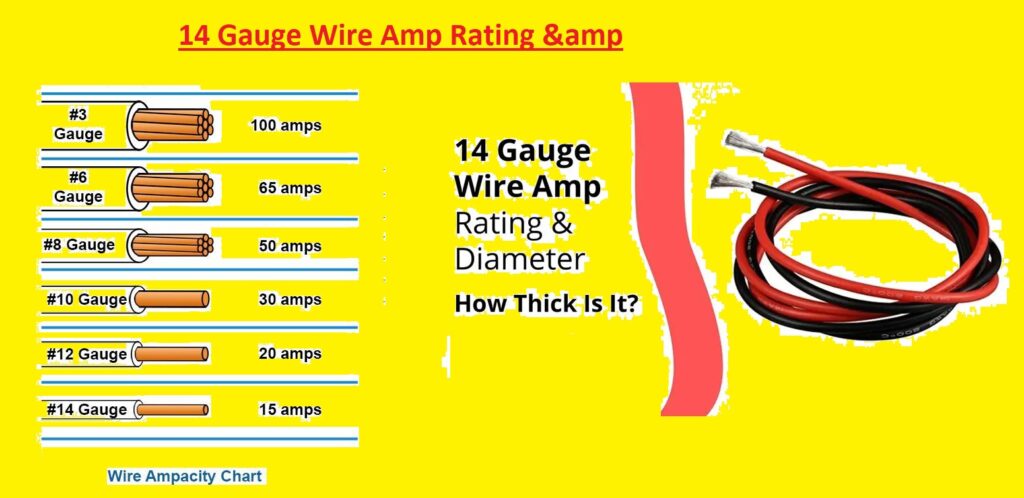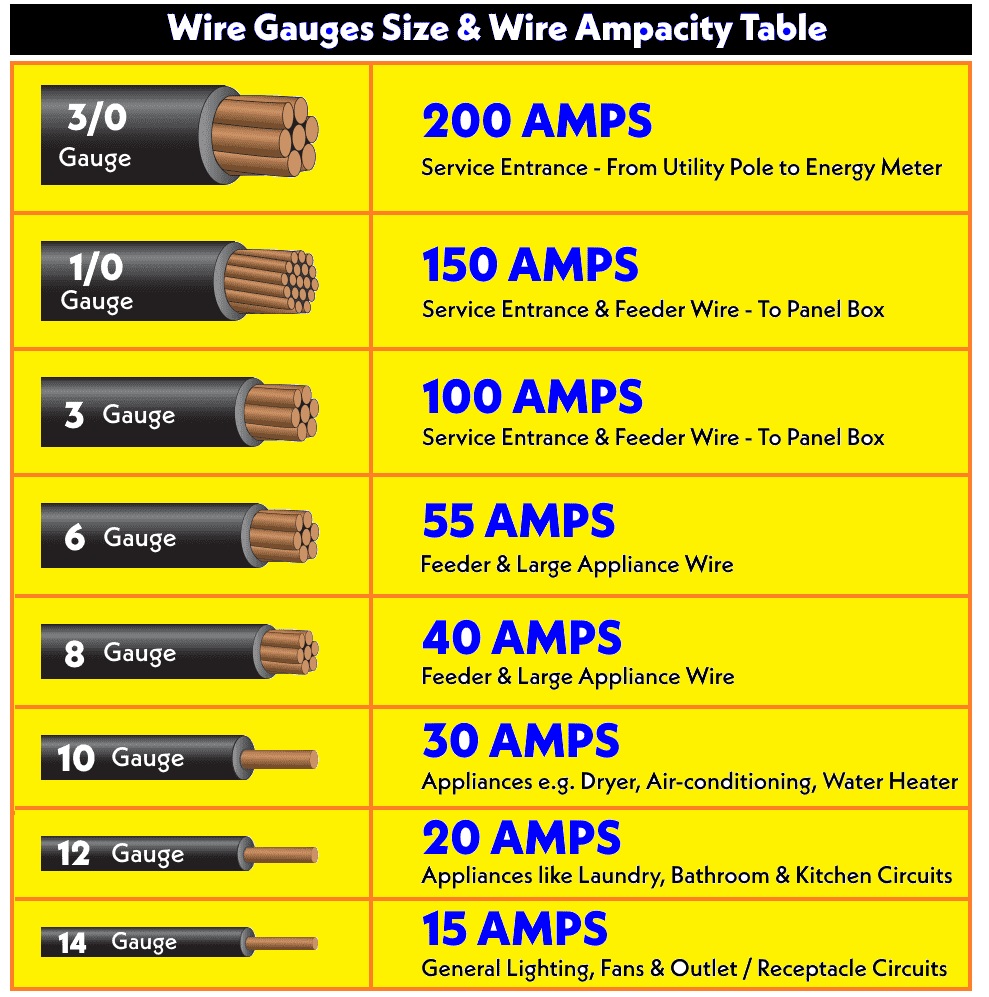Hello readers welcome to the new post. In this post, we will discuss 14 Gauge Wire Amp Rating & Diameter: How Thick is 14 Gauge Wire? 2024 Guide. The 14 gauge wire is used to power the devices that do not need high current. That 14 gauge wire is also used for wall power outler, but it’s ampacity or current load features define that they are not good for these uses Here we will cover differnt parameters to learn the 14 gauge wire thickness and ratings and other parameters. So let’s get started with 14 Gauge Wire Amp Rating
Introduction 14 Gauge Wire Amp Rating &
14 Gauge Wire Dimensions
The 14 AWg wire has these dimension
- Its diameter is 1.6277 mm, 0.0641 inches, and its cross-section area is 2.0809 mm2, 0.0032 inches2,
Amp Rating
Here are the 14 gauge wire amps:
- 90°C/194°F: 25 Amps.
- 75°C/167°F: 20 Amps,
- 60°C/140°F: 15 Amps,
- 60°C/140°F: 15 Amps x 0.8 = 12 Amps
- 75°C/167°F: 20 Amps x 0.8 = 16 Amps
- 90°C/194°F: 25 Amps x 0.8 = 20 Amps
How Far Does A 14 Gauge Wire Run Before Voltage Drop?
14 gauge wire can be set to about 15 meters before voltage losses for 120-volt circuits.
The main factors for voltage losses are heat, power, or resistance.
For a 120-volt circuit having 14 gauge wires, for 100 feet, voltage losses will be 3.3 percent. If crosses 50 feet for 240 volts the voltage losses will be 6.6%.
For 240 volts it will reduce to 232.08 volts, and for 120 will be 116.04 volts. So two time voltage and distance mean losses will be double
For 14 gauge wire 12 or 10 gauge has features to handle larger loads and long distances with less voltage losses. For thin wires, gauges of 16 or 18 are good for weight loads and small distances
Should I Use 12 Or 14 Gauge Wire For Outlets?
Both 14 gauge wire and 12 gauge wire can be used in home electrical outlets. The gauge of wires explains the thickness. Every gauge is denoted with a number. A small number means the wire is thick and a high number means thin wire.
Thick gauge wire has features to handle high power. The 14 gauge wire is used with a 15 amp circuit. The 12 gauge is used for a 20 amp circuit.
We can also use 12 gauge wire for a 15 amp circuit due to the thicker wire.
The 15 gauge wire is not used for a 20 amp circuit since it is thin for handling 20 amps.
The 12 gauge wire is used on both 15 and 20-amp circuits. But are costly. Larger devices and high-power devices use 20 amps wire.
How To Tell if The Wire is 12 or 14 Gauge?
- 14 gauge wire diameter: 0.0641 inches,
- 14 gauge cross-section zone: 0.0032 inches
- 12 gauge wire diameter: 0.0808 inches
- 12 gauge cross-section zone: 0.0051 inches
Differences between 12-gauge and 14-gauge wire:
12 gauge wire was used for 20 amp circuits and 14 gauge wire was used for 15 amps. Both wire gauges are mostly used at residential applications.
The thickness of 12 gauge wire is higher than 12 gauge wire
12 gauge wire has features to handle 14 gauge wire
Fewer voltage losses for 12 gauge wire for long distances than 14 gauge wire.
Both wires come with 3 wires, white, black, and ground
12 gauge wire used for 20 amp circuits
14 gauge is for 15 amp circuits
12 gauge is also best for 15-amp circuits.
Both 12 and 14-gauge residential wires contain 3 wires: black, white, and ground.
14 Gauge Wire Cables: 14/2 Wire, 14/3 Wire, and 14/4 Wire
- 14/2 Wire (14 2 Wire): It has 2, 14 gauge wire conductors and one ground wire
- 14/3 Wire (14 3 Wire): it has 3, 14 gauge wire conductors and one ground wire
- 14/4 Wire (14 4 Wire): It comes with 4, 14 gauge wire and 1 ground
Amp rating for 14 gauge wire
The gauge of wire defines the rating of the fuse or circuit breaker in the ampere. The circuit wired with 14 gauge copper will use a 15 amp circuit breaker. The circuit having 12# copper uses a 20 amp breaker.10# copper uses 30 amps
Max amps for 14 gauge wire
| NM, TW, & UF WIRE | SE CABLE (Copper Conductor) |
|---|---|
| 14 AWG – 15 AMPS | 8 AWG – 50 AMPS |
| 12 AWG – 20 AMPS | 6 AWG – 65 AMPS |
| 10 AWG – 30 AMPS | 4 AWG – 85 AMPS |
| 8 AWG – 40 AMPS | 2 AWG – 115 AMPS |
14 Gauge Marine Wire
14 gauge marine wires come with an ampacity of 14 gauge wires but due to marine uses, they come with good corrosion protection and strong mechanical insulation for protection from mechanical impacts and vibrations.
As it needed some more factors so 14 gauge marine wire is more costly than 14 gauge wires
If there is a 14 gauge marine wire that needs to be used for normal 14 gauge wire can easily be used but not be used normal 14 gauge wire for 14 gauge marine wire.
Can 14 gauge handle 16 amps?
The 14 gauge nonmetallic sheathed Romex cable does not have more than 3 current carrying wires is limited to 60 degrees insulation temperatue rating and can handle 15 amperes at the ambient temperature of 30°C
Can 14 gauge handle 15 amps?
14 AWg copper wire is commonly used for 15 amp circuits. 14 AWG copper wire ranked 20 amp for 75 degrees. if there is to use aluminum wire accurate size for the 15-ampere breaker is 12 AWg. but copper cable is best for 15 amper breakers due to efficiency.
Is 14 2 good for 20 amps?
How many volts is a 14 gauge wire?
120 Volt
Is 14 2 good for 30 amps?
The 30-ampere breaker allows double current 14 gauge wire can handle and causes overheating wire for fire hazard
Can I Use 14 Gauge Wire For An Outlet?
14 gauge wire is only used wire for 15 amp circuits. it is not safe to use 14 gauge wire for an outlet of 20 amp since ampre is high for wire. it can be a chance of wire overheating, damage, and also cause fire. 14 gauge wire is best to use for an outlet with 14 amp or low circuit.
Do not use 14 gauge wire for an outlet on circuits more than 15 amp. Check the breaker box for measuring the ampere of the circuit of the outlet.
How Many Outlets Can You Put On 14 Gauge Wire?
14 gauge wire was used for the 15 amp circuit as discussed. On a 15 amp circuit, we can connect 8 receptacles that are four outlets. Each outelt must use 1.5 amperes and so use about 80 percent of the circuit’s maximum ampere. It means a 15 amp circuit with 14 gauge wire will have 88 receptacles or 4 outlets.
Size 14 wires attached to 200 amp breaker
If a 14 gauge wire is connected with a 200 amp main breaker followed by an open short full 200 amps will race down the 14 gauge wire. The wire not only gets hot it will get fire in the wall. it will move like a firecracker. If a proper 15 amp breaker is used then 200 amp then heat on the wire will result in 15 amp breaker tripping before the 14 gauge wire gets hot. The 100 amp breaker will not trip before getting fire
What Wire To Use For Outlets
| Wire Use | Circuit Amperage | Wire Gauge |
|---|---|---|
| Light fixtures, lamps, lighting circuits, | 15 amps | 14-gauge or 12-gauge |
| Kitchen, bathroom, and outdoor receptacles (outlets), 120-volt air conditioners | 20 amps | 12-gauge |
14 Gauge Wire Advantages
The 14 gauge wire is thin copper and less costly than the 12 gauge wire.
- 14-gauge wire is less costly than 12-gauge wire.
- it has a flexible nature so it easily be sent to longer distances.
- it is best for residential outlets
- I used it for 15-amp circuits.
- It is commonly used in residential construction and standard wire for 15 amp circuit.
- Kitechern grades use a 15-amp circuit with a 14-gauge wire.
14 Gauge Wire Disadvantages
- The 14 gauge wire with a 15 amp circuit does not give the requried AC unit, power tools, etc.
- If there is a need to use a 14 gauge wire with a 15 amp circuit and upgrade the system to 20 amps, replace the wiring with a 12 gauge. It is a difficult process and can be costly.
- For using 12 gauge wire on a 15 amp circuit just replace the breaker. It is easy to low cost since wiring can handle 20 amps
- 14 gauge wire and 15 amps are not used for each outler. Kitchen and bathroom outlets must come with a 20 amp circuit with 12 gauge wire.
Difference Between 14/2 Wire And 14/3 Wire?
| Features | 14/3 wire | 14/2 wire |
|---|---|---|
| volt circuit | 240V | 120V |
| Qconductors | 3 | 2 |
| No of wires | 4 | 3 |
| Cost | pricier | more affordable |
Read Also:
- 30 Amp Wire Size: What AWG Wire You Need?
- 125 Amp Wire Size and Breaker Guide
- 60 Amp Wire Size – Which AWG is Best for 60 Amp Breaker
- What Size Wire for 200 AMP Service Underground
- What Size Wire for 100 Amp Service
- What Size Wire Do I Need for a 60 Amp Sub Panel?
- HOW MANY AMPS CAN 2 AWG WIRE HANDLE?
FAQs
How many amps for 14 gauge wire?
| Amperage Capacities for Standard Non-Metallic (NM) Cable | |
|---|---|
| 14-gauge wire | 15 amps |
| 12-gauge wire | 20 amps |
| 10-gauge wire | 30 amps |
| 8-gauge wire | 40 amps |
Can 14 gauge wire handle 20 amps?
The 14 gauge wire on the 20 amp circuit is not an accurate size, since it is rated for handling 15 amp in residential loads. The use of 14 AWG for a 20 amp breaker will cause overheating and chances of fire.
How many continuous amps can a 14 gauge wire handle?
14 AWG cables are typically rated for 15 amps, without any interruption.
Is 14 gauge wire good for 30 amps?
The circuit wired with 14 copper gets a 15 amp circuit breaker, and with use of the wrong wire size for the circuit can be dangerous. it can cause Overheating. Sparking.
Can 14 gauge wire handle 40 amps?
Electrical codes avoid 14 AWG wires over 15 amperes. It does not matter whether the wire is 6 inches long or 47 feet.
What size wire for 30 amps?
10-gauge wire is good for 30 amps
What size wire for 40 amps?
8 AWG is wire size for 40 amp
What size wire for a 50 amp?
The 6 amp size of wire that is required for a 50 amp circuit,
What gauge wire for 50 amp 220v?
6 AWG copper wires and 4 AWG aluminum wires in the 50 Amp circuit
What gauge wire for 60 amps?
For 60 amps 6 AWG wire is the right size. Use RHW or THHN-type insulation. The wire of # 8 gauge is best for 50 amps
What wire is good for 100 amps?
Normally wire size for 100 amp service is 4 AWG or 2 AWG for copper wiring and 2 AWG, 1 AWG, or 1/0 AWG for aluminum or copper-clad wiring. This size is used for direct burial.
What wire for 70 amps?
For 70A, use can use 3 AWG, 2 AWG, or 1 AWG (or larger) wire with a 70A breaker.
What size wire for 65 amps?
| Copper | ||
|---|---|---|
| 6 | 55 | 65 |
| 4 | 70 | 85 |
| 3 | 85 | 100 |
| 2 | 95 | 115 |







